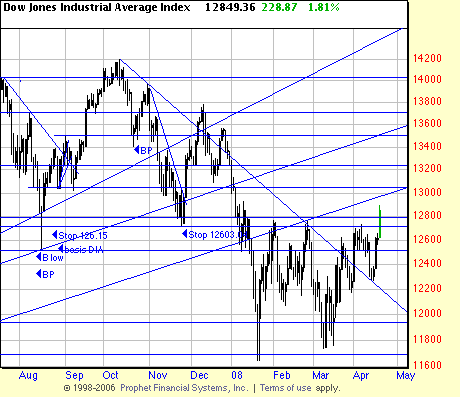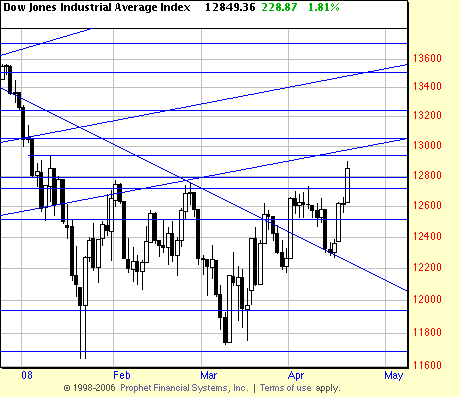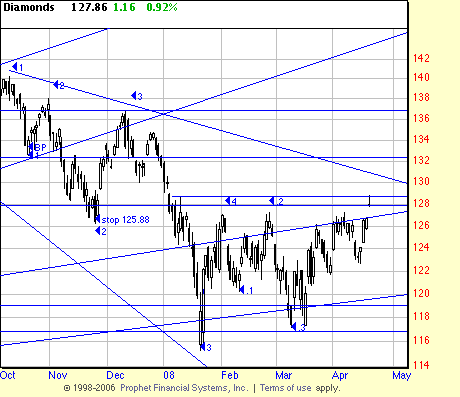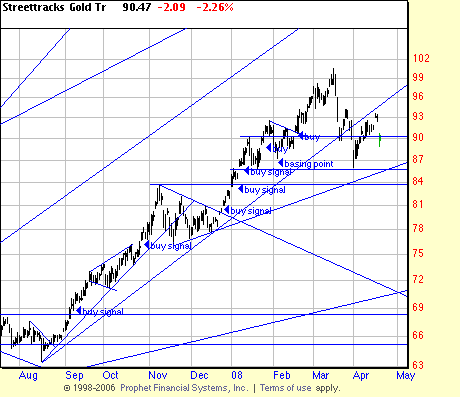
We thought that the trading range shown here was well defined, and that Friday’s price surge might be a breakout. Then we looked at it again and saw what you will see below, that our original line was not totally definitive. (Actually no line is totally definitive. Interested parties attempt to mess with the lines, and that is why John Magee remarked that trend line breaks shouldn’t be considered dispositive until they had broken the line by 3%. )

A closer look reveals that it is no breakout at all. It alters the pattern to this point, but it is still within the range as illustrated in the next panel.

Here the limit line of the pattern is redrawn. We ignore the Friday gap, since the $indu is the important basis. In general that is most always true. So, as usual we must wait until next week to see whether this is really meaningful, or if it is market misbehavior.
We can do exact numbers to find out why the primary options dealers were willing to pump the market last week.
The answer can be found in the excellent work of Sophie Xiaoyan Nia, Neil D. Pearsona*, Allen M. Poteshmana, “Stock price clustering on option expiration dates”, Journal of Financial Economics 00 (2002) 000-000. According to this learned treatise, when dealers collude to alter the expiration price, bringing it closer to the critical put or call price by 16.5 basis points (on all stocks upon which options are written) they save approximately $9 billion. We can use Wachovia as an illustrative example to figure how much money they saved by manipulating stock prices on Friday. Upon the initial news of terrible earnings and the need for capital injection, WB’s price dropped to $24.74 per share. By the end of the week, on Friday, it was selling for $27.24 per share. That is a change of 250 basis points. If we assume that most stocks were manipulated to a similar extent, we reach the following algebraic: 16.5/9 = 250/x. 16.5x=2250. x=$136.37 billion dollars. Wachovia was probably an extreme example. On the other hand, the market for options has quadrupled since those economists wrote the article. The number of overall put derivatives, in particular, floating in the market, has been elevated by a factor of about 2.5, for a total of 8.5 times as big an effect from each basis point. Therefore, using WB still provides a very conservative exemplar. Even assuming that WB was manipulated 4x more than the average stock, the end result would be 1/2 that of the market as a whole.
It is clear, from this, that the primary dealers saved themselves AT LEAST $136 billion, and possibly, $300-400 billion, by manipulating stock prices up last week, and insuring a clustering above, or near, the critical put price points. Had they paid out on the puts, many of the biggest and most venerable names in banking and finance would have been plunged into bankruptcy, both in Europe and America.
That being said, pumping markets and creating artificial prices, also costs money. However, because the total value of stocks traded each day, is far less than the nominal value of derivatives, it costs far less. The total dollar volume on all the exchanges in the United States, on an average trading day, is about $130 billion. Last week, the S+P500 rose by about 4.4%. The dealers may have pumped or supported the market on about four days. Even if we were to assume that they did the pumping evenly, on most of the days, which they didn’t, the maximum expenditure could not have been more than $22.9 billion. In fact, however, the pumping was done primarily on two days, with a little bit of pumping or market support on a third and fourth. So, the factor to use is probably close to 2.5. If we do the math, we find that it cost derivatives dealers a minimum of $13.5 billion to push prices on Wall Street up last week against the market. We cannot ignore, of course, that the market must have wanted to go down, given the horrible news. If we assume that, absent market manipulation, the markets would have fallen by 4.4%, then, the total cost was $27 billion. That is a net savings of $109 billion, which is the absolute minimum. More likely, the savings was closer to double that, or $218 billion. That is why, much to the surprise of rational people, the “dirt of the DOW” soared last week.
The quoted is from a “John MD” on Marketwatch. It makes too much sense to be total hogwash. And, more importantly, colleagues in the business have hinted to us that such behavior is not uncommon.

It appears that the gold market is back on. Certainly the recent reaction did nothing but establish a basing point for long term traders.Being moderately aggressive we would be buying here. Conservatives would be buying new highs.

